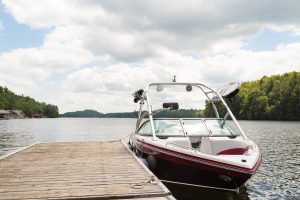Boat Storage Tips
Keep your RV in good shape by properly storing your RV.
Storing your boat inside of a storage facility is a great way to keep your boat safe, while freeing up drive-way space at your home. That being said, if you plan on keeping your boat inside of storage facility, here are some tips to keep in mind.
1. Clean and Inspect Your Boat
Clean your boat before storing it. You can’t properly protect your boat if there is dirt or grime on both the interior and exterior. Start at the bow and work toward the stern, making sure to get into all the nooks and crannies where dirt likes to hide.
Next, check for any dents or cracks in the fiberglass or gel coat. Repair as needed using quality marine-grade epoxy resin filler followed by a skim coat of high-bond primer surfacer to fair out imperfections.
2. Battery Storage and Maintenance
The next storage tip involves properly securing and removing your batteries. Make sure the terminals are clean from corrosion, which can damage their ability to hold a charge post storage. Next, check all cables for any signs of wear or damage from storage as well, such as frayed wires or burned insulation.
The storage area will be extremely hot during storage season, so monitoring battery temperature before storage is important. This way, you can measure how much energy they have lost over that time frame and replace them if needed before taking them out again in the spring. If everything looks good, then disconnect your battery cables and place them on a storage rack in the storage area, prepped and ready for when it’s time to hit the water again.
3. Eliminate Any Chances of Frozen Moisture
Moisture can be one of your biggest threats when it comes to getting your boat ready for storage, especially during the cold season. You need to make sure that all moisture is removed before putting your boat away for the winter. When you use a hose to clean out your engine compartment, be sure you also open up all the compartments.
Pay close attention to places like behind bulkheads or lockers where water can get trapped. Afterward, take all drain plugs out, so they are completely drained by morning. Make sure to use a dry cloth or towel to absorb any moisture inside. If you have an onboard freshwater system, open the faucets too so they can drain fully.
4. Covers and Tie-Downs
The best way to protect your boat from the harsh winter elements is to use a quality storage cover. Not only will it keep the dust and dirt off, but it’ll also help prevent fading and sun damage. Be sure to get a cover that is made specifically for boats, as they are designed to resist water, weather, and UV damage.
5. Check the Gasoline
Gasoline is another major factor to consider when getting your boat ready for storage. It’s important to store your boat in a well-ventilated area, especially if you have a gas-powered engine. If you can, try and siphon out all the gasoline from the tank before storage.
This will help to prevent any moisture or condensation from building up inside and causing corrosion. If you can’t siphon it all out, then be sure to add a fuel stabilizer to the tank. This will keep the gasoline fresh and help to prevent any build-up over time.
6. Engine Maintenance
One of the most important things you can do before storage is to properly maintain your engine. This means removing all the water by hosing it down and then using compressed air to blow out any remaining water. You also want to clean off any salt or dirt that may have built up.
Be sure to use an appropriate lubricant on all moving parts and apply a rust inhibitor to any metal surfaces. If you are not able to do this yourself, take your boat to a reputable marine service center for a full engine tune-up.
7. Drain All Fluids
Before storing your boat, you’ll want to drain all of the fluids from the engine, transmission, gearbox, and outdrive. Draining these fluids will help reduce the risk of corrosion. If you’re storing your boat outside, it’s a good idea to either remove the plugs from those same ports or place some kind of sealant in them. You can use wax or an adhesive product.
8. Lubricate All Moving Parts
Don’t forget to properly lubricate all moving parts before you store your boat. It is very important that you use a marine-grade lubricant for this step because most automotive oils will turn into a solid wax after being exposed to water and colder temperatures.
9. Consider Pests Before Winter Storage
You might not think about boat pests as a problem when preparing your boat for storage, but they can pose a serious threat during the winter months. You see, their body temperatures decrease as the temperature drops outside. This means that rats and mice will become even more active looking for food sources inside your boat at night, making your vessel their new home.
One simple way to prevent this is by putting dryer sheets behind all storage compartments or in the bilge area, so they don’t become infested during cold weather months. You can also ensure that your storage facility is safe from pests and vermin that could harm your boat.
10. Winterize Your Boat
One of the best storage tips involves having your boat winterized for storage. Since you’re storing your boat in a colder climate, it’s important to winterize the engine to protect it from freezing. This typically involves adding a special antifreeze mixture to the cooling system and then running the engine for a few minutes.

Need Boat Storage in Las Vegas, Nevada? Look no further than Nellis Self Storage!
Few will do a better job of keeping your boat in great shape during the off season than professional storage. If you live in or around Las Vegas, Nevada, there is no better place to store your boat than right here at Nellis Self Storage. To learn more about our boat Storage spaces and rates, tap here.
